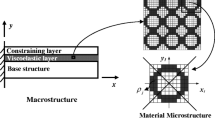Abstract
To damp the flexural vibrations of homogeneous beams or plates in a large frequency range, one of the most efficient methods is the use of constrained viscoelastic layers. Since most of the damping ability is due to shearing stresses in the viscoelastic layer, it is interesting to determine the most appropriate distribution of the shear in the layers. This paper presents the influence of a new parameter involved in this repartition, i.e. the distribution of cuts in the elastic constraining layer. It will be demonstrated that modal damping may be significantly modified in this way. The number and the locations of the cuts may vary and are determined to optimize the damping. The vibrating beam modal analysis is performed by a finite element analysis using special finite elements which have variable d.o.f. in order to take into account the lack of continuity of the viscoelastic constrained displacement field. Using a genetic algorithm, an optimal distribution of the cuts has been determined for a maximum damping of one or serval flexural modes.
Similar content being viewed by others
References
Di-Taranto, R.A. 1965: Theory of vibratory bending for elastic and viscoelastic layered finite length beams.J. Appl. Mech. ASME 87, 881–886
Hajela, P.; Lin, C.-Y. 1991: Optimal design of viscoelastically damped beam structures.Appl. Mech. Rev. 44, 96–106
Johnson, C.D.; Kienholz, D.A. 1982: Finite element prediction of damping in structures with constrained viscoelastic layers.AIAA J. 20, 1284–1290
Marcelin, J.-L.; Trompette, P.; Dornberger, R. 1995: Optimization of composite beam structures using a genetic algorithm.Struct. Optim. 9, 236–244
Mead, D.J.; Markus, S. 1969: The forced vibration of a threelayer, damped sandwich beam with arbitrary boundary condition.J. Sound & Vib. 10, 163–175
Ross, D.; Ungar, E.E.; Kerwin, E.M. 1959: Damping of plate flexural vibrations by means of viscoelastic laminate.Structural Damping, ASME, 49–88
Trompette, P.; Boillot, D.; Ravanel, M.-A. 1978: The effect of boundary conditions on the vibration of a viscoelastically damped cantiveler beam.J. Sound & Vib. 60, 345–350
Trompette, P.; Marcelin, J.-L.; Schmeding, C. 1993: Optimal damping of beams and plates by genetic algorithms.Proc. IUTAM Symp. (held in Zakopane, Poland), pp. 1–11
Author information
Authors and Affiliations
Rights and permissions
About this article
Cite this article
Trompette, P., Fatemi, J. Damping of beams. Optimal distribution of cuts in the viscoelastic constrained layer. Structural Optimization 13, 167–171 (1997). https://doi.org/10.1007/BF01199236
Received:
Issue Date:
DOI: https://doi.org/10.1007/BF01199236




